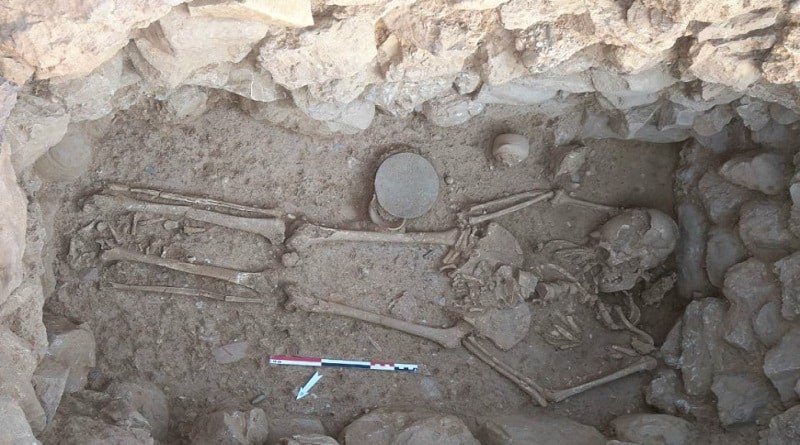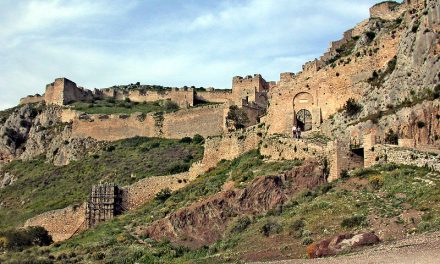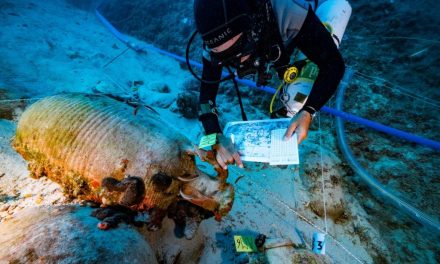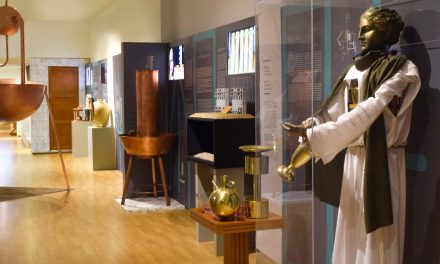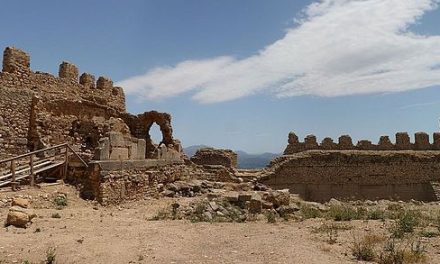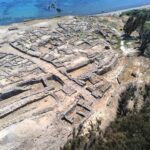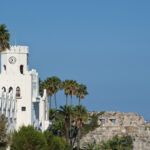The Sissi Archaeological Project (S.Ar.P.edon) is an extensive excavation programme on a site near the modern village of Sissi, a small resort town in the region of Lasithi in east Crete. The project attempts to unveil the mysteries about the rules of power and the complex structure of Minoan society which gradually collapsed after 1450 BC. The excavations have uncovered ruins of prehistoric buildings as well as other important findings; some of the most recent include the discovery of a rare cist grave containing an almost complete woman’s skeleton with impressive grave goods.
The Sissi Archaeological Project is an initiative of the Université Catholique de Louvain and operates in Greece under the auspices of the Belgian School of Athens (EBSA). Funds for the new excavations are generously provided by the Institute for Aegean Prehistory, the UCL, the FNRS, the EBSA and the Ministère de l’Enseignement supérieur, des Médias et de la Recherche scientifique de la Fédération Wallonie-Bruxelles, as well as a series of private donors and the local community of Vrachasi and Sissi.
Besides its scientific goals, the project also provides qualitative training to future generations of archaeologists in a multidisciplinary and international working environment while involving local communities to ensure the sustainable preservation of the site. A first five-year programme of excavations took place between 2007 and 2011 of which the finds are still being studied; summer of 2019 saw the completion of the 10th fieldwork campaign, and with it the second five-year programme.
 Building CD – the LM III complex seen from the south (© Sissi Project)
Building CD – the LM III complex seen from the south (© Sissi Project)
The project’s name, S.Ar.P.edon, is inspired by the mythical king Sarpedon, son of Zeus and brother of Minos and Rhadamanthus; according to the legend, the three brothers ruled over Crete, with Sarpedon dominating over the eastern part of the island until he was exiled by Minos.
Site History
The interdisciplinary archaeological project focuses on the coastal hill Kephali, locally known as Buffos, and its environs, located near the modern village of Sissi in east Crete. As Professor Jan Driessen (UCLouvain), director of EBSA and director of the Sissi Excavations , writes in the site’s historical presentation on the project’s official website, S.Ar.P.edon is “one of the most important Bronze Age excavations in Crete during the past decade, because of its extent, chronological range and the type of buildings uncovered”.
Kephali hill sits less than 4 km east of the site of the archaeological site of the Minoan Palace of Malia; with a beach on both sides, the hill lies at the outlet of the river flowing down the Selinari gorge, which is exactly opposite the Kephali. This gorge formed the only overland access from central to east Crete and its strategic position was attracted the attention of early settlers; from its initial foundation around 2600 BC, it remained occupied until the end of the Bronze Age, around 1200 BC. During its early history, the Kephali was apparently only one out of a series of small hamlets, which dotted the coast of the larger Malia Bay but soon it would outgrow its neighbours and become the second settlement after Malia in the region.
Apart from architectural remains of the Early and Middle Bronze Age (c. 2600-1750 BC) on the summit of the hill, an adjoining cemetery of house-like tombs was installed at the north foot of the hill, close to the sea. This allowed the evolution of burial rites until the sudden abandonment of the cemetery in the 18th century BC. As Driessen explains, the abandonment coincided with the destruction of the First Palaces on the island, including the violent devastation of nearby Malia Palace.
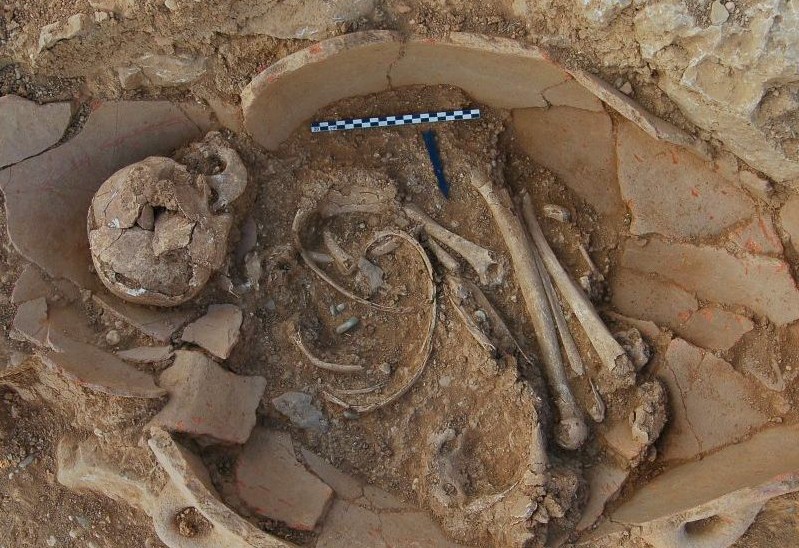 MM IIB Pithos burial in the cemetery(© Sissi Project)
MM IIB Pithos burial in the cemetery(© Sissi Project)
According to the archaeologist, what happened in the following period is not quite clear, but the possibility exists that the Kephali steered a more independent course. The clearest indications for this are the construction of a fortification wall at the foot of the hill and especially the creation of a court-centred complex on a lower terrace of the summit, intentionally incorporating earlier remains in its construction. Its central court, made of plaster and with a size of at least 450 m², could host larger crowds for festivals and religious meetings, as indicated by some ritual installations that were found. At or around the time of the Santorini eruption, however, this ceremonial complex was abandoned although the remaining settlement continued.
He notes that Sissi was eventually destroyed by fire not long after the eruption, and the nature of occupation drastically changed. On the summit of the hill, the ruins of one or more Neopalatial houses were partly incorporated and overbuilt by a new type of structure that betrays influences of the Mycenaean Mainland: one large complex organised around two columnar halls with central hearths with a small snake-tube shrine between them. During its occupation, it suffered from an earthquake destruction accompanied by fire after which it needed rebuilding. In the late 13th century BC, the complex and the rest of the site were suddenly abandoned. Fortunately, apart from metal, all other objects were left in place, allowing a proper reconstruction of its internal functioning. The Kephali hill would, in the centuries to follow, become a place of memory and gradually disappear from history until excavation works began in 2007 by the UCLouvain team.
Latest discoveries
More than 100 archaeologists of various nationalities took part in the 10th fieldwork campaign at Sissi, headed by Professor Jan Driessen. According to a Press release issued by the Greek Ministry of Culture and Sports, the S.Ar.P.edon team further uncovered parts of the court-centred complex. Also, the excavation near the west wing of the monumental complex brought to light significant remains of an Early Minoan IIA settlement (ca. 2600 BC).
 Gold necklace from the cist grave of the Late Minoan II period (©EBSA, M.Anastasiadou)
Gold necklace from the cist grave of the Late Minoan II period (©EBSA, M.Anastasiadou)
At the court-centred complex, a floor coated with excellent quality mortar was unearthed, with a dotted decoration and a ceramic pipeline. On other spots, ruins from lesser-known periods were discovered, among them a house destroyed during the Middle Minoan IIIA period and a cist grave belonging to the Late Minoan ΙΙ-ΙΙΙΑ1, which had been constructed inside an earlier mortuary site of the Neopalatial period.
The meticulously constructed grave contained an almost complete and intact woman’s skeleton, buried with a bronze mirror with an ivory handle, garment pins made of bone and bronze, and a gold necklace strung with 15 olive-shaped larger beads and 15 smaller ones. It is noted that these types of burial are relatively rare on Crete, found only at Knossos and Chania.
Read also via Greek News Agenda: The Griffin Warrior unlocks secrets of the Mycenaean civilisation; Yannos Kourayos, bringing the archaeological site of Despotiko to life; Professor Michael Scott: By studying the ancient Greeks we learn more about ourselves
N.M. (Intro photo: Latest findings, cist grave of woman of the Late Minoan II period [©EBSA, J. Driessen])
TAGS: ARCHEOLOGY | HERITAGE | HISTORY | MODERN GREEK STUDIES

